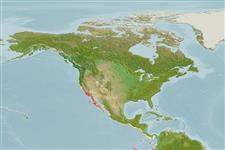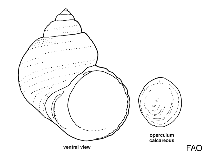Megastraea undosa (Wood, 1828)
Wavy turban| Native range | All suitable habitat | Point map | Year 2050 |

|
| This map was computer-generated and has not yet been reviewed. |
| Megastraea undosa AquaMaps Data sources: GBIF OBIS |
Upload your photos
Google image | No image available for this species;
drawing shows typical species in Turbinidae.
Google image | No image available for this species;
drawing shows typical species in Turbinidae.
Classification / Names Common names | Synonyms | CoL | ITIS | WoRMS
Gastropoda | Trochida | Turbinidae
Environment: milieu / climate zone / depth range / distribution range Ecology
Benthic; depth range 1 - 100 m (Ref. 121891). Subtropical; 34°N - 24°N, 120°W - 111°W
Distribution Countries | FAO areas | Ecosystems | Occurrences | Introductions
Eastern Pacific: from Point Conception, California, USA to Bahia Magdalena, Mexico.
Length at first maturity / Size / Weight / Age
Maturity: Lm ? range ? - ? cm Max length : 15.0 cm SHD male/unsexed; (Ref. 121668)
Coastal (Ref. 121668). It is found on rocks, usually in kelp beds, from low intertidal to a depth of 21 meters (Ref. 865). Also in subtidal habitats (Refs. 121666, 121667) and rocky reefs (Ref. 121668). Herbivorous (Refs. 121666, 121667), primarily feeds on the giant kelp Macrocystis pyrifera; also consumes a variety of fleshy and calcareous macroalgae (Ref. 121667).
Life cycle and mating behavior Maturity | Reproduction | Spawning | Eggs | Fecundity | Larvae
Members of the order Patellogastropoda are mostly gonochoric and broadcast spawners. Life cycle: Embryos develop into planktonic trocophore larvae and later into juvenile veligers before becoming fully grown adults.
Main reference
References | Coordinator | Collaborators
Bisby, F.A., M.A. Ruggiero, K.L. Wilson, M. Cachuela-Palacio, S.W. Kimani, Y.R. Roskov, A. Soulier-Perkins and J. van Hertum. 2005. (Ref. 19)
IUCN Red List Status (Ref. 130435)
CITES status (Ref. 108899)
Not Evaluated
CMS (Ref. 116361)
Not Evaluated
Threat to humans
Human uses
Fisheries: commercial
| FishSource |
Tools
More information
Internet sources
BHL | BOLD Systems | CISTI | DiscoverLife | FAO(Publication : search) | Fishipedia | GenBank (genome, nucleotide) | GloBI | Gomexsi | Google Books | Google Scholar | Google | PubMed | Tree of Life | Wikipedia (Go, Search) | Zoological Record
Estimates based on models
Preferred temperature
(Ref. 115969): 15.9 - 24.4, mean 18.6 (based on 60 cells).
Resilience
(Ref. 69278):
Medium, minimum population doubling time 1.4 - 4.4 years (K=0.24).
Price category
(Ref. 80766):
Unknown.



